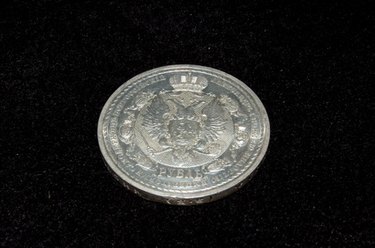Things You'll Need
Crucible
Safety goggles
Leather work gloves
Oxy-acetylene torch
Flint striker

Before you attempt to melt a silver coin for jewelry, make sure your coin actually consists of silver. Some old and commemorative coins are silver, but more common silver-tone coins actually consist of zinc, copper, nickel and other base metals and have little to no silver. Coin silver tends to melt at a slightly lower temperature than pure silver—1615 degrees Fahrenheit, compared to 1761—but both types are simple to melt with an oxy-acetylene torch.
Step 1
Set your silver coin in a crucible intended for jewelry-making or metalwork. Crucibles may be made of graphite or other materials that stand up to high temperatures. If you will be using a centrifugal casting machine, use your casting machine's crucible. If you are hand pouring, a melting crucible is best.
Video of the Day
Step 2
Put on safety goggles and leather work gloves, and make sure you do not have bare skin exposed. If you have long hair, tie it back to prevent it getting in the flames.
Step 3
Turn on the acetylene gas to low, and then squeeze the trigger on your flint striker until a spark ignites the gas. Flint strikers tend to be safer than gas-based lighters for this application.
Step 4
Turn up the oxygen, and adjust both the oxygen and gas knobs until you have a bluish cone about 1/2-inch long at the base of the flame.
Step 5
Slowly circle the flame over the coin, always keeping it moving. Keep the point of the bluish cone about 1/8 inch away from the coin as you move the torch, and keep circling slowly until you thoroughly melt the coin.
Video of the Day